Qin tomb
archaeological site, China
Wade-Giles romanization Ch'in (World Heritage site)
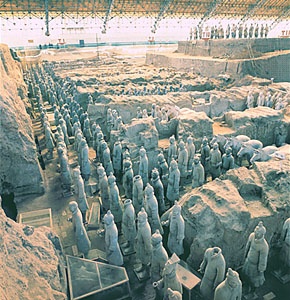
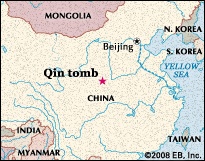
major Chinese archaeological site near the ancient capital city of Chang'an, Shaanxi (Shensi) sheng (province), China, now near the modern city of Xi'an. It is the burial place of the first sovereign emperor, Shihuangdi of the Qin dynasty (221–207 BCE), who unified the empire, began construction of the Great Wall of China, and prepared for death by constructing a 20-square-mile (50-square-km) funerary compound, the treasures of which began to come to light only some 2,100 years after his death.
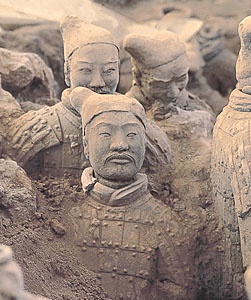
 In March 1974 a work brigade of farmers drilling a well discovered a subterranean chamber that archaeologists later found contained an army of some 8,000 life-size terra-cotta soldiers (assembled from separately fired sections but given individually detailed faces) and horses, along with richly adorned chariots of wood (now disintegrated) and of bronze; iron farm implements; bronze and leather bridles; objects of silk, linen, jade, and bone; and such weapons as bows and arrows, spears, and swords, cast from an unusual 13-element alloy, which are still shiny and sharp today. The clay figures, once brightly painted with mineral colours, were grouped into a specific military formation—a configuration of vanguard bowmen and crossbowmen, outer files of archers, groups of infantrymen and charioteers, and an armoured rear guard—that followed the military prescriptions of the time. Three nearby chambers—one holding more than 1,300 ceramic figures representing a smaller, complementary force of foot soldiers, chariots, and cavalry, one with 68 members of what probably represents an elite command unit, and one that is empty—were also discovered in the 1970s. Buried above and around many of the broken figures are the remnants of timber roofing, which may have collapsed because of a fire shortly after the emperor's death. These four so-called Xi'an digs are covered with protective roofing and, even as the archaeologists' work proceeds, serve as the unique in-site Museum of Qin Figures; a new exhibit hall was opened above one of the pits in 1994.
In March 1974 a work brigade of farmers drilling a well discovered a subterranean chamber that archaeologists later found contained an army of some 8,000 life-size terra-cotta soldiers (assembled from separately fired sections but given individually detailed faces) and horses, along with richly adorned chariots of wood (now disintegrated) and of bronze; iron farm implements; bronze and leather bridles; objects of silk, linen, jade, and bone; and such weapons as bows and arrows, spears, and swords, cast from an unusual 13-element alloy, which are still shiny and sharp today. The clay figures, once brightly painted with mineral colours, were grouped into a specific military formation—a configuration of vanguard bowmen and crossbowmen, outer files of archers, groups of infantrymen and charioteers, and an armoured rear guard—that followed the military prescriptions of the time. Three nearby chambers—one holding more than 1,300 ceramic figures representing a smaller, complementary force of foot soldiers, chariots, and cavalry, one with 68 members of what probably represents an elite command unit, and one that is empty—were also discovered in the 1970s. Buried above and around many of the broken figures are the remnants of timber roofing, which may have collapsed because of a fire shortly after the emperor's death. These four so-called Xi'an digs are covered with protective roofing and, even as the archaeologists' work proceeds, serve as the unique in-site Museum of Qin Figures; a new exhibit hall was opened above one of the pits in 1994.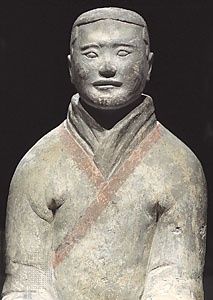 The buried army faces east, poised for battle, about three-quarters of a mile from the outer wall of the tomb proper, guarding it from Shihuangdi's chief former adversaries, who had come from that direction. In pits nearby have been found the remains of seven humans (possibly the emperor's children), a subterranean stable filled with horse skeletons, an assemblage of half-size bronze chariots, 70 individual burial sites, a zoo for exotic animals, and other artifacts.
The buried army faces east, poised for battle, about three-quarters of a mile from the outer wall of the tomb proper, guarding it from Shihuangdi's chief former adversaries, who had come from that direction. In pits nearby have been found the remains of seven humans (possibly the emperor's children), a subterranean stable filled with horse skeletons, an assemblage of half-size bronze chariots, 70 individual burial sites, a zoo for exotic animals, and other artifacts.The tomb itself, which may have been looted shortly after its completion, remains unexcavated. It lies within an inner wall and beneath a four-sided pyramid mound that was originally landscaped to appear as a low, wooded mountain. The interior is reputedly a vast underground palace that took about 700,000 conscripted workmen more than 36 years to complete. The historian Sima Qian (c. 145–c. 87 BCE) wrote:
The labourers dug through three subterranean streams, which they sealed off with bronze to construct the burial chamber. They built models of palaces, pavilions, and offices and filled the tomb with fine vessels, precious stones, and rarities. Artisans were ordered to install mechanically triggered crossbows set to shoot any intruder. With quicksilver the various waterways of the empire, the Yangtze and Yellow rivers, and even the great ocean itself were created and made to flow and circulate mechanically. With shining pearls the heavenly constellations were depicted above, and with figures of birds in gold and silver and of pine trees carved of jade the earth was laid out below. Lamps were fueled with whale oil so that they might burn for the longest possible time.
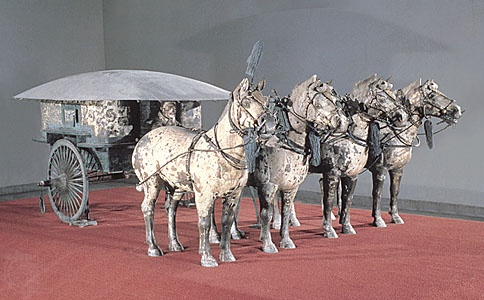 The compound was declared a UNESCO World Heritage site in 1987. Archaeological excavations on the site continued into the 21st century, and archaeologists anticipated that it would take years to unearth the entire tomb complex.
The compound was declared a UNESCO World Heritage site in 1987. Archaeological excavations on the site continued into the 21st century, and archaeologists anticipated that it would take years to unearth the entire tomb complex.The region surrounding the Qin tomb holds the mausoleums of several other ancient Chinese rulers, including those of Taizong, second emperor (626–649 CE) of the Tang dynasty, and the Han emperor Wudi (141–87 BCE).
Additional Reading
The discovery of the terra-cotta soldiers is related in two biographies of Shih huang-ti: Arthur Cotterell, The First Emperor of China (1981); and R.W.L. Guisso et al., The First Emperor of China (1989), a well-illustrated work. Edmund Capon, Qin Shihuang (1982), covers the background of the figures. O. Louis Mazzatenta, “China's Warriors Rise from the Earth,” National Geographic, 190(4):68–84 (October 1996), is also recommended.
- Sedan
- sedan
- Sedan, Battle of
- Sedang language
- sedarim
- Sedaris, David
- sedative-hypnotic drug
- Seddon, Richard John
- seder
- Sederholm, Jakob Johannes
- sedge
- Sedgefield
- Sedgemoor
- Sedgemoor, Battle of
- Sedgwick, Adam
- Sedgwick, Anne Douglas
- Sedgwick, Catharine Maria
- sedilia
- sedimentary facies
- sedimentary rock
- sedimentation
- sedimentation tank
- sedimentology
- sedition
- Sedley, Sir Charles, 4th Baronet